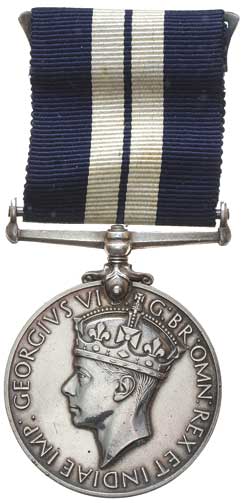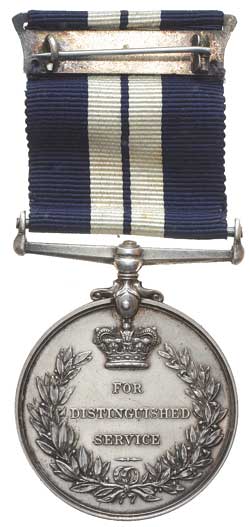Orders, Decorations & Medals - Australian Groups
Lot 3925 Session 15 (7.30pm Thursday) Orders, Decorations & Medals - Australian Groups
Estimate $20,000
Bid at live.noble.com.au
DSM GROUP TO HMAS SYDNEY II CASUALTY: Distinguished Service Medal (GVIR Indiae Imp); 1939-45 Star; Africa Star; also Bartolomeo Colleoni Medal. R.A.N.19251 G.Rosevear. A.B. H.M.A.S.Sydney. on first medal, second and third medals unnamed as issued, G.Rosevear. A.B. O.N.19251. on last medal. First medal impressed, last medal engraved. No ribbons on second and third medals, very fine.
DSM: LG 27/12/1940, p7279, posn 6, for Gallant and successful services destruction of "Bartolomeo Colleoni".
Award received by Commonwealth Navy Board direct from London and forwarded to next-of-kin, Mrs E.Rosevear (wife).
MID: LG 24/6/1943, with remarks 'See D.S.M., card'.
Together with,
1) Photos.
2) Form and Order of a Solemn Memorial Service held in the Cathedral of St. Andrew, Sydney on Thursday, 4th December, 1941 in memory of The Officers and Men of H.M.A.S.Sydney and H.M.A.S.Parramatta.
3) Newspaper cutting from The Sydney Morning Herald, Tuesday, February 11, 1941 Welcoming the cruiser Sydney and crew on their return after a long absence abroad featuring a replica as given to the ship's crew of the City of Sydney's gift plaque to commemorate the sinking of the Bartolomeo Colleoni.
4) Booklet for A National Service of Thanksgiving and Remembrance on Thursday 24th April 2008 at St Andrew's Cathedral, Sydney Square, Sydney for those lost in HMAS Sydney II, 19 November 1941, endorsed on front cover, 'To Kay - In honour of Geoff and Lance Rosevear - and their service to Australia - (signed) K Rudd Prime Minister'.
5) Poster by Royal Australian Navy, HMAS Sydney II, 1935-1941 featuring Honour Roll of officers and crew.
6) Book titled, The Search for the Sydney, How Australia's Greatest Maritime Mystery Was Solved, by David L. Mearns, published by HarperCollins Publishers Pty Limited, 2009, 264pp with colour and b&w photos throughout and index. (unidentified photo on p148 of three crewmen appears to feature AB C.Rosevear at far right)
7) Photo of plaque erected in 2001 by HMAS Sydney & Vietnam Logistical Support Veterans Association and the Department of Veteran Affairs to commemorate the 60th Anniversary of the loss of HMAS Sydney and with list of Tasmanian casualties. The plaque, that includes the names of Able Seaman Geoffrey Rosevear DSM and his brother Able Seaman Lance Rosevear, is situated at Franklin Wharf, Kings Pier, Hobart, Tasmania.
8) Four CDs as follows, 'The Loss of HMAS Sydney II - Commissioner The Honourable Terence R H Cole AO, RFD, QC; HMAS Sydney II National Memorial Services 16th April - 24th April 2008 'We Will Remember Them'; HMAS Sydney II Memorial Services 19th November 2008; HMAS Sydney II Photography Finding Sydney Foundation.
For the Bartolomeo Colleoni action, there were six DSMs awarded as follows, Chief Petty Officer A.P.Prior, Chief Petty Officer S.G.Silk, Chief Ordnance Artificer W.J.Keane, Chief Stoker J.N.Beaumont, Able Seaman G.Rosevear, Stoker E.Evans.
Geoffrey Rosevear, born 03Jan1911 at Launceston, Tasmania; Enl.12Feb1929; Home Port of Melbourne, Vic; KIA 20Nov1941 in Indian Ocean on HMAS Sydney II; Geoffrey's brother, Lance, was also serving on the Sydney; Lance Rosevear, born at Don, Tasmania 24Mar1916; Enl.10Jun1935; Home Port Melbourne, Vic; KIA 20Nov1941 in Indian Ocean on HMAS Sydney II.
In The Examiner newspaper, March 19, 2008 the cousin of the Rosevear brothers was interviewed. She revealed that the boys' father was a merchant in Devonport and traded from a place right on the Esplanade opposite the wharf. The brothers had enjoyed a visit home to Tasmania before the fateful last voyage of the Sydney II. She said Geoffrey had moved to Sydney before the war. He was raised in Devonport but he married a girl named Eileen from Bondi and lived in Sydney. Lance married a girl named Olive from Scotland. After their visit home, they went back to the mainland on the old SS Taroona and caught the train to Sydney. Halfway between Melbourne and Sydney the train pulled up suddenly and all sailors were taken off. They went back to the ship and were never heard from again. After the loss of the brothers, their cousin said rules were implemented to ensure that in future brothers did not serve on the same ship in wartime.
Both brothers are commemorated at the Australian War Memorial and at the Plymouth Naval Memorial at Plymouth, Devon, England.
Battle of Cape Spada (sinking of Bartolomeo Colleoni)
HMAS Sydney II, on 18 July 1940, in company with the destroyer HMS Havoc, responded to an enemy report from HMS Hyperion and, sailing to meet the British destroyers, opened fire at 20,000 yards on two pursuing Italian cruisers, Bartolomeo Colleoni and Giovanni Delle Bande Nere. The Italians returned fire, turned away and made smoke and thus the action became a chase. Initially hits were scored on the 'Bande Nere'. In order to prevent the Italians rounding Cape Spada, Captain Collins of the Sydney directed that fire be concentrated on Bartolomeo Colleoni. Hits were being registered on her, still at long range but eventually she succumbed to the numerous hits and lost speed. She was down in the bows and on fire and so was left by Sydney for the destroyers to finish her off.
Sydney then pursued 'Bande Nere' but could not keep apace with the faster Italian cruiser and, with her ammunition virtually expended, abandoned the chase when the enemy was no longer visible. During the action, Sydney sustained only one hit, to her forward funnel, which did not affect her performance.
The attack group of six ships returned to Alexandria around 11:00 on 20 July after fending off several air attacks, one of which damaged HMS Havock, and were met by cheering from all ships in the harbour. For his actions, Captain Collins was appointed a Companion of the Order of the Bath, while other officers and sailors from the Sydney received three Distinguished Service Orders, a Distinguished Service Cross, six Distinguished Service Medals, and twelve Mentions in Despatches and Sydney was awarded the battle honour 'Spada 1940'.
Sydney returned to Australia in February 1941 to wide public acclaim for her Mediterranean campaign. She was met by the Governor-General and the Minister for the Navy, the Honourable William Hughes. The Premier of NSW and the City of Sydney Lord Mayor went on board and presented a plaque to the ship to commemorate the victory over the Bartolomeo Colleoni on behalf of the citizens of Sydney. The plaque was composed of two large cast medallions mounted on oak and was affixed to the gun housing of 'Y' turret below the sighting ports. Capt Collins then led a march of the ship's company through the streets of Sydney to the Town Hall for a civic reception. Thousands lined the route and school children were given the day off school so they too could join in the celebrations. At the civic reception each crew member was presented with a medallion, being a miniature version of that presented to the ship, namely the Bartolomeo Colleoni Medal. All medals were individually inscribed to each recipient.
Loss of HMAS Sydney II in the Indian Ocean with all hands on board.
On the afternoon of 19 November 1941, Sydney was off the coast of Western Australia, near Carnarvon, and heading south towards Fremantle. Around 15:55, the cruiser spotted a merchant ship on a northbound course, which quickly turned away from the coast at 14 knots (26 km/h; 16 mph). Sydney increased speed to 25 knots (46 km/h; 29 mph) and made to intercept. As she closed the gap, Sydney began to signal the unidentified merchantman, first by signal light, then after no reply was forthcoming and the distance between the two ships had decreased, by a combination of light and signal flag. The merchant ship hoisted her call sign, but as she was ahead and just port of Sydney, the flags were obscured by the funnel. A request from the cruiser that the merchant ship make her signal letters clear, which the signals officer did by lengthening the halyard and swinging the flags clear. The call sign was that of the Dutch ship Straat Malakka, but she was not on Sydney's list of ships meant to be in the area. Further flag signals were exchanged between the ships, with Sydney asking the Dutch ship's destination and cargo.
At 17:00, a distress signal was transmitted by Straat Malakka, indicating that she was being pursued by a merchant raider. Following this, Sydney pulled alongside the merchant ship from astern; pacing the merchantman on a parallel course, approximately 1,300 metres (4,300 ft) away. Sydney's main guns and port torpedo launcher were trained on the ship, while she sent the interior portion of Straat Malakka's secret call sign. Fifteen minutes later, at around 17:30, the merchantman had not replied, and Sydney sent a signal ordering her to show the secret call sign.
Straat Malakka had not replied because she was the German auxiliary cruiser Kormoran in disguise, and when asked to reveal a call sign the Germans did not know, they responded by decamouflaging and opened fire. Prompted by the raider's unveiling, Sydney also fired, but while her first salvo either missed or passed through Kormoran's upper superstructure with minimal damage, four of the raider's six shells inflicted heavy damage on Sydney. A battle ensued and eventually Sydney broke off and was seen limping off into the distance. At night a fire on board her was visible on the horizon and finally disappearing some time after midnight when she sank. The disabled Kormoran with fires below decks that could not be contained was scuttled for fear that mines in the hold and the gun magazines would explode.
American shipwreck hunter David Mearns first learned of the battle in 1996, and began to study it as a prelude to a search for the ships in 2001. Mearns, with the aid of other researchers, focused on primary sources, and came to the conclusion that the German accounts of the ships position were true. After attracting the interest of the RAN, Mearns entered into a partnership with HMAS Sydney Search, a not-for-profit company set up to administer and help fund an expedition to locate Sydney and Kormoran. After an extensive search Sydney was located on 17 March 2008 just after 11:00, only hours after Kormoran's discovery was made public. Sydney's wreck was located in the Indian Ocean 2,468 metres (8,097 ft) below sea level, 11.4 nautical miles (21.1km; 13.1 miles) south-east of the raider. The bow of the cruiser had broken off as the ship sank, and was located at the opposite end of a debris field stretching less than 500 metres (1,600 ft) north-west from the hull, which was sitting upright on the ocean floor. On discovery, both wrecks were placed under the protection of the Historic Shipwrecks Act 1976 and they were also placed on the Australian National Heritage List on 14 March 2011.
With research.
Estimate / sale price does not include buyer's premium (currently 22% including GST) which is added to hammer price. All bids are executed on the understanding that the Terms & Conditions of sale have been read and accepted. For information on grading and estimates please refer to the Buying at Auction advice.
Quick find
View a lot by number and sale.
Adjacent lots
Lot 3923
GROUP OF FIVE TO MERCHANT NAVY CAPTAIN: 1939-45 Star; Atlantic Star; Pacific Star; War Medal ...
Estimate $300
Lot 3924
FAMILY GROUP: Group of Six to pilot KIA: 1939-45 Star; Air Crew Europe Star; Defence ...
Estimate $2,500
Lot 3925 This lot
DSM GROUP TO HMAS SYDNEY II CASUALTY: Distinguished Service Medal (GVIR Indiae Imp); 1939-45 Star; ...
Estimate $20,000
Lot 3926
GROUP OF SEVEN TO CASUALTY: 1939-45 Star; Africa Star, - clasp - 8th Army; Pacific ...
Estimate $400
Lot 3927
GROUP OF FIVE (ACCIDENTAL DEATH WHILE ON LEAVE): 1939-45 Star; Africa Star; Defence Medal 1939-45; ...
Estimate $280

